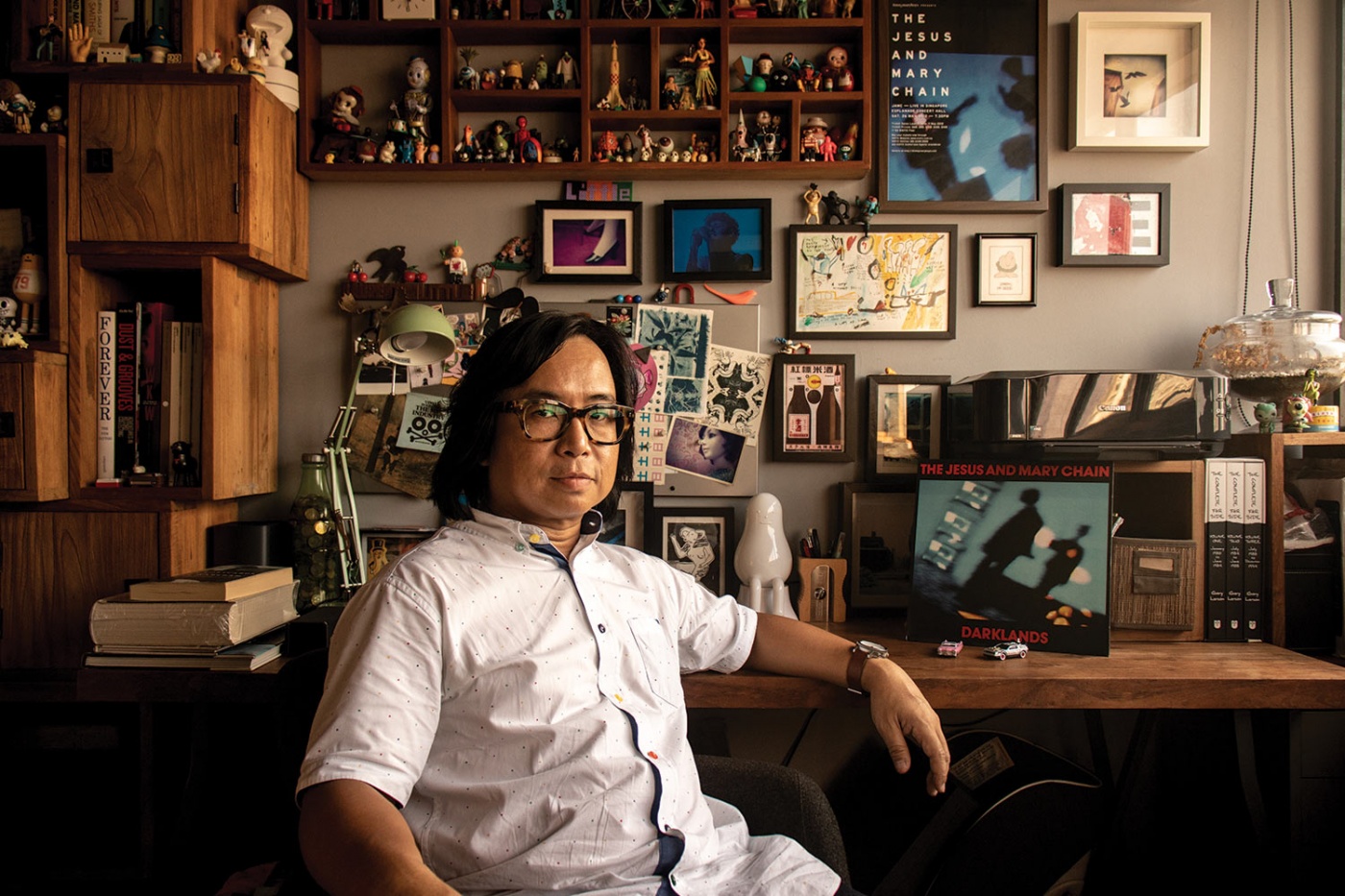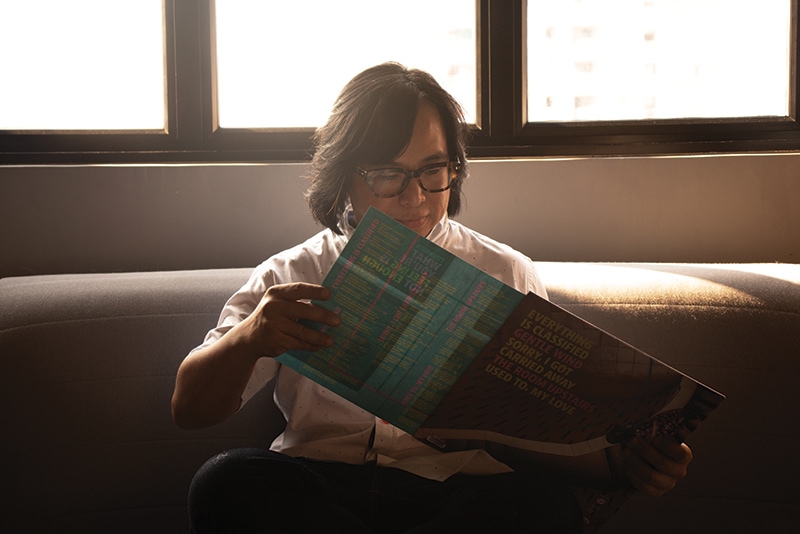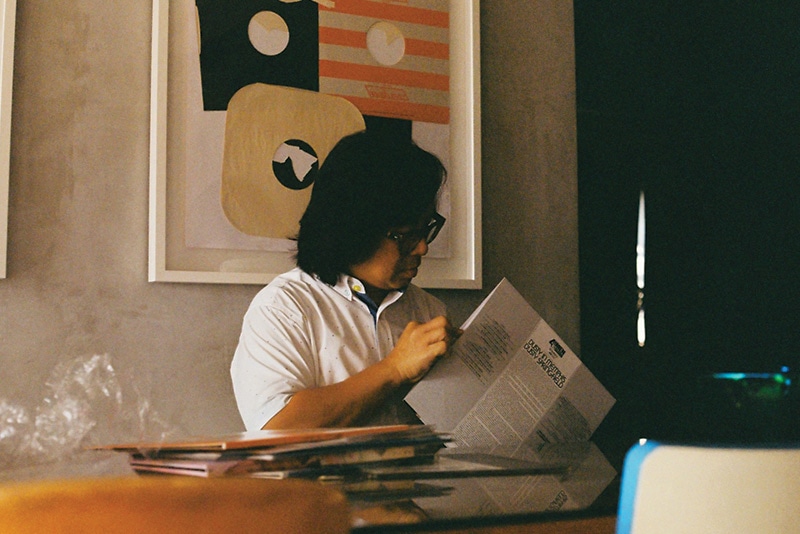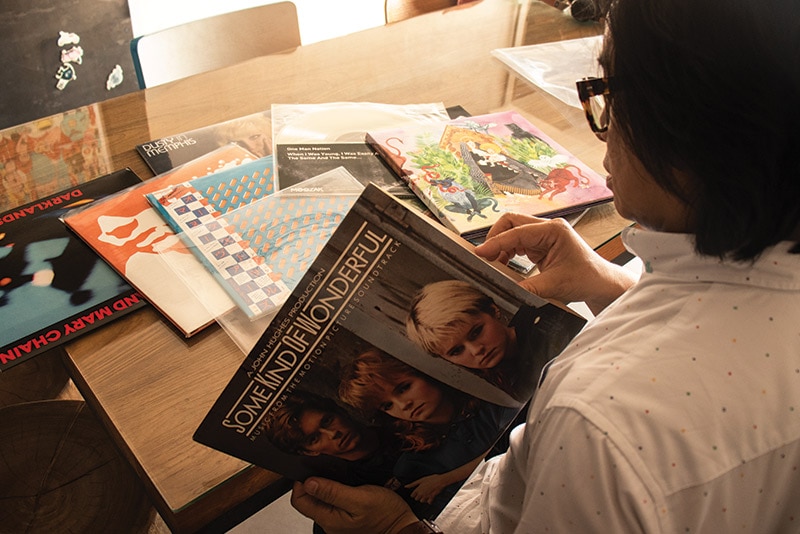What’s My Obsession: Talking Vinyl with Little Ong
Meeting Little Ong is like catching up with an old friend. Perhaps it might be his amiable demeanour that puts me at ease, or the eclectic decor of his abode that speaks to me. A quick gander reveals an extensive shelf loaded with vinyl records, artworks hanging on the walls, and an eye-catching fish tank by the side of the window. If Little’s home is an insight into his personality, I soon discover that he has been keeping aquarium fishes and designing fish tanks for a year now. “I’m learning a lot about how to make them sustainable on their own and that intrigues me,” he says. “Keeping a tank is really about sustaining a planted environment underwater, so I started a small pond at the back as well.”
Apart from fish tanks, another passion that runs deep is Little’s love for vinyl records. As a child, he grew up listening to Cantopop songs from his mother’s cassettes, and bought his first vinyl record after earning enough money on his own. “Music has always been a key driver in my life,” he says. After graduating from NAFA, Little started working for BigO, Singapore’s only rock and roll magazine, where he honed his skills and prowess as a graphic designer for 7 years. Having that exposure has opened up doors for Little—allowing him to work with musicians and local bands to create album covers, collaterals, and videos. Currently, he runs fFurious, a multidisciplinary creative agency which has been around for 20 years.
Throughout the interview, Luca, his son, lingers around and stares at me with inquisitive eyes while his wife prepares dinner. When I ask Little what excites or inspires him, he says, “My wife and my son.” The family of three partakes in activities such as cruising along the beach on their longboards while Luca rides on his scooter, and watching a gig together whenever an opportunity arises. Shortly, Luca points at a pastel-hued record with colourful illustrations; ‘I Love You, Honeybear’ by Father John Misty is his favourite album, and Little takes it out from the shelf. Pop-up graphics appear and a tune starts playing—just like a Christmas card.
Maybe it’s the striking colours that attracted Luca, but upon witnessing the tender moment between father and son, I gather that the true value of Little’s vinyl collection is when he is able to share it with someone.
HNW: Why are you fascinated by vinyl?
Little Ong: I believe that the record format is the best representation of music. You get inserts and artworks to look at and as a designer, that excites me and has stuck with me throughout the years since I started collecting music in the 80s—at the peak of the vinyl era. I like that it is tactile and I can hold onto it while listening to music.
Playing vinyl records is a cumbersome process. Do you find that therapeutic?
I don’t think about the process because I have been playing records for so long that I am used to it. I take pleasure in zoning out whenever I take one out to admire and clean it. If I’m listening to it for the first time, I will try to read the lyrics too. It’s not a chore to me.
Do you use other mediums to listen to music?
I download or stream music. I haven’t bought a CD in a really long time unless it’s a local band releasing their album, because it’s really expensive to produce a record. If you want to support your favourite bands, buy their albums whether they are CDs, cassettes or digitally. Some of them do have records, but it’s not common.
What first drew you to music?
I believe it’s destiny. Music has always been in my life. As a kid, I always had music playing in the household because my mum would listen to Cantopop or disco songs; my granddad listened to music too. Growing up, I found solace in music or I got energised by it. I borrowed my mum’s cassettes at first, but when I started earning a bit of money, the first thing I bought were records. I collected them for awhile, and during the whole CD revolution, I actually sold all my records away, which was definitely one of the biggest mistakes in my life! I started recollecting a few years back. Music found me and it means a lot to me—probably more so than other people. And it was definitely a part of my coming-of-age. My friends were all into music, even the kind of magazines I used to read, or discovering that Singapore had its own music scene back in 1988. That very year, I went to my first local concert in Singapore Botanic Gardens, incidentally organised by BigO, as my friend was playing in a band and I wanted to support him. Since then, a whole new world opened up for me and I discovered that Singapore has an amazing music scene. When I graduated from NAFA, I did my final year project on a revamp of BigO magazine. It had good content but needed juicing up on the visual side.
Is the magazine still around?
No, it ceased in the early 2000s. For my final year project, I decided to revamp the magazine, which led to me designing for them for about 7 years. During that period, I was exposed to the local and global music scene. I started designing for a lot of friends in the music industry and continued to do so even after starting fFurious. Even until today, destiny plays a big part when it comes to collecting vinyl records, and as the saying goes, “You don’t find the records, the records find you.” [laughs] There may be certain albums that you really want, but you just can’t find them. Then one day, you walk into a store, pick up a pile of records on the floor and it’s lying there.
Designers like Stefan Sagmeister launched his career by designing album covers for Lou Reed and The Rolling Stones. Would you agree that your career path was set in motion by the music industry?
I didn’t do Arts for the longest time because they didn’t have that subject in secondary school and I went on to do my ‘A’ Levels in commerce. After my national service, I actually applied for fine arts in NAFA because I wanted to do silkscreening and darkroom photography. However, I was told to do graphic design instead (I had no idea what it was back then). When I was in NAFA, it was during the grunge era in the mid-90s. There was a magazine called Ray Gun and David Carson was the director—he had a way of approaching graphic design and music design that was so inspiring. There were also bands like Pixies and Lush from 4AD and their designs by Vaughan Oliver were really incredible too. So all these were huge influences on me, which in a way, led me to where I am today.
What will you be doing if music wasn’t a part of your life?
I have never thought about that. I don’t know. [laughs] It’s hard for me to imagine my life without music. Even when I’m at work, I will put on a certain soundtrack or album and that influences how I design and create.
Do you see yourself as an old soul?
No, I think I have a very young soul. I realised that a lot of my friends stopped exploring music around their twenties. They just listen to whatever they are familiar with, but I am constantly trying to discover new music. It makes me feel alive. I get very excited when I find interesting new music, but at the same time, I also love old music.
How do you discover new music?
I read music sites and blogs. I also join Facebook groups where we talk and share music. I also read music biographies; those are my favourite books to read. Over the last few years, I started reading music biographies and I learned a lot about their inspiration. Recently, I read about Tracey Thorn—she is part of the musical duo Everything but the Girl. She talked about her influences and one of them was Dusty Springfield. After reading that, I bought Dusty in Memphis. This is the most recent example of how I discover new music, just by reading something.
[Read: What’s My Obsession: Talking Fashion with Tan Min-Li]
Currently, what are your favourite bands?
There are so many, where do I start? In the local music scene, there are a lot of exceptional artistes. Bands like Hanging Up the Moon, Riot !n Magenta, Sobs, Cosmic Child, just to name a few. As for global bands, Superorganism is really compelling and I’m excited that the band Luna came back and started playing again.
Do you attend local music festivals like Baybeats?
Yes, definitely! Force Vomit, a band that I designed their first CD release 20 years ago, is playing their 20th anniversary gig at Baybeats. We are designing their video backdrops and anniversary T-shirt for them as well. I’m also looking forward to watching Love X Stereo from Korea. I caught them briefly when I was in Seoul a few years ago. Recently, we attended Sobs’ gig at Kilo Lounge and they played a really good set. I still go to gigs whenever I can, however, it’s challenging because I want to spend time with my son during the weekends. I try to go on weekday nights if I’m not too busy at work. Whenever we travel, we also try to catch a gig.
How do you procure your records? Is there a store that you frequent?
Locally, I will go to Hear Records out of convenience because my studio is in Chinatown and there’s one that is just 5 mins away. Most of the time, I will order online from Amazon and Juno. I also order straight from the label, like Elefant Records. I go to Discogs to get records that I can’t find elsewhere. Sometimes I will buy straight from the band because a lot of them do sell their records directly.
Analog vs. Digital music, what are the pros and cons?
The obvious advantage of digital would be its accessibility and portability, it’s not possible to lug a turntable everywhere you go. A lot of audiophiles swear by the sound quality of vinyl, as you get the full range whereas digital is compressed, so it doesn’t reach in and touch your soul as much as a record does. Digital music could end up being background music; as for analog you have to dedicate more time and effort into listening to it. In digital formats, you also lose the tactile experience, whereas in analog you get many different options with regard to the packaging (collaterals, etc). Just having the opportunity to read the lyrics while you play the music is really special to me.
Do you believe that vinyl will become obsolete eventually?
They were rendered obsolete before, but there is a resurgence. I hope it stays that way because personally, I think it is the most interesting music format out there today. Surprisingly, according to reports, the sales of vinyl records have increased dramatically in recent years. I don’t know if they will ever die off again. Even if that happens, at least I still have my collection to listen to.
How do you keep track of your collection? Is there a system you use to arrange them?
I arrange them alphabetically. I also have a section for unsorted records and those that I haven’t played yet. There were a few occasions where I kept buying the same records, only to return home and realise that I already had them. Now I keep track of my collection on Discogs. Discogs is a site where you can buy records from other collectors, and it allows collectors to catalogue their collection. You can sell your records on the marketplace, but I mostly use the site to catalogue what I have and it is very convenient. Most of the newer records have a barcode, so I scan it using the app and it goes automatically into the system. Whenever I’m in a record store and feel like buying one, I can just check to see whether I own the record, and that prevents me from buying duplicates.
How does your collection inspire your work?
As a creative person, I take pleasure in looking at creative things. Some people collect paintings to put on their walls, while others collect beautiful photographs to look at. I collect records, and those are my artworks too. I’ve learnt so much about typography, photography and digital imaging. Sometimes when I’m trying to achieve a certain style, I will refer to vinyl artworks to draw inspiration from their designs.
What are some of your most prized records?
I do have some rare ones in my collection, but I didn’t buy them because of their monetary value. I buy records that I really want to listen to. There are also times when I bought records because of the format. The packaging for Father John Misty’s album is really intriguing and the record comes in lollipop colours, so I had to buy it. There are some people who collect records because they like the colour of the vinyl, but it’s just a piece of plastic. At end of the day, I buy vinyl records because I like the music.That being said, I do have some limited edition records where only 100 or 200 copies were produced. I also have a collection of Dick Lee’s albums and singles because I grew up listening to them during my teens.
What would the soundtrack of your life sound like?
It probably will be the Some Kind of Wonderful soundtrack. It is a movie by John Hughes, which is still a great classic to watch these days. It has a phenomenal soundtrack which comprises many alternative rock bands at the time. It is the perfect soundtrack to a good movie. You can find the record easily, but to me, it is a highly treasured soundtrack.
What’s your favourite work that your agency has done for a record?
Probably our most recent one. We designed an EP for a local band called TypeWriter. I did all the photography and we worked on the art direction as a team. There was also a whole series of photographs that came out on their Facebook page, promotional singles, and covers. It also comes as a really nice coloured marbled vinyl. We even did their launch gig, where we produced projection videos for the band and I shot the concert. I think the biggest bonus of working on all these new albums is that I get to listen to the music before everyone else does. When we work on a project like that, I try to let the music transport me, which allows me to visualise the mood or feeling. We spent a lot of time working on this EP but we had a great time doing it.






